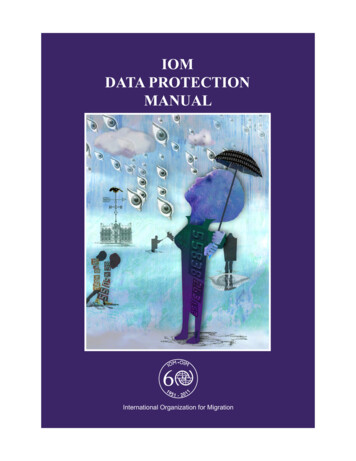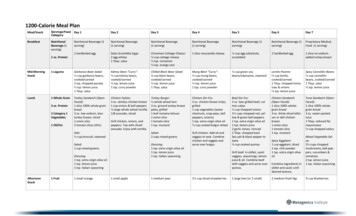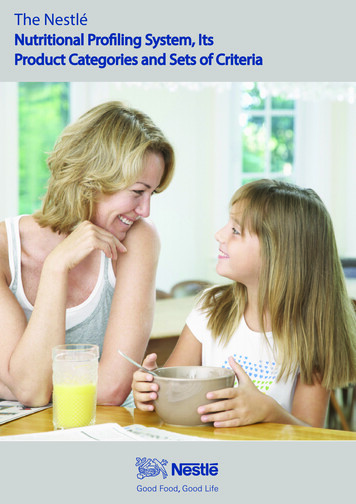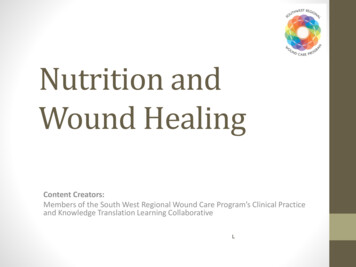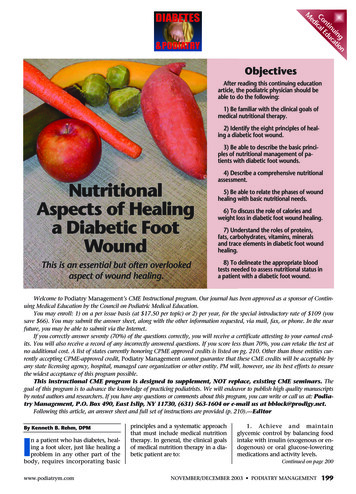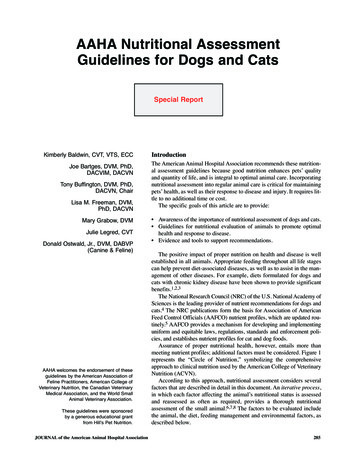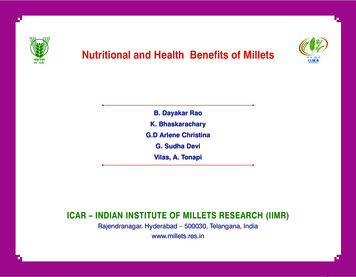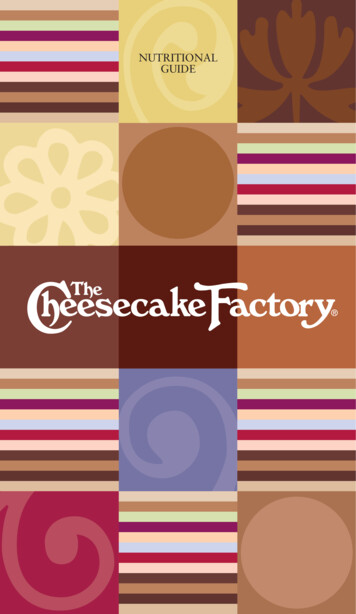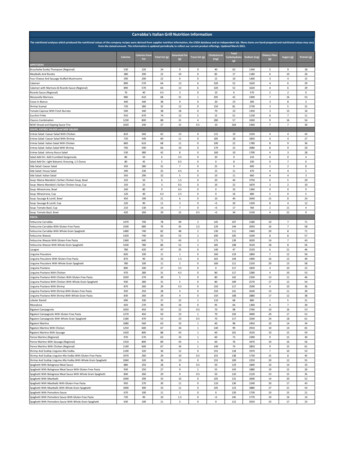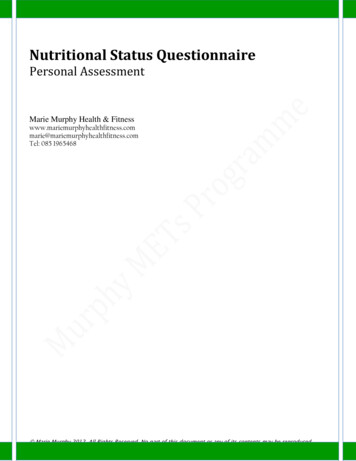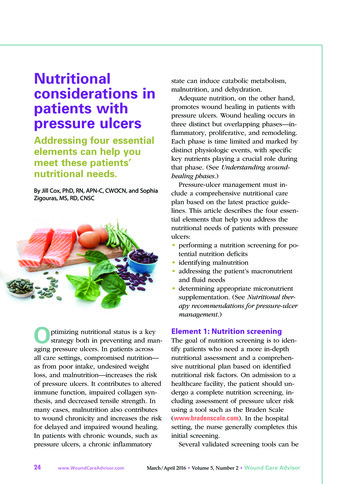
Transcription
Nutritionalconsiderations inpatients withpressure ulcersAddressing four essentialelements can help youmeet these patients’nutritional needs.By Jill Cox, PhD, RN, APN-C, CWOCN, and SophiaZigouras, MS, RD, CNSCOptimizing nutritional status is a keystrategy both in preventing and managing pressure ulcers. In patients acrossall care settings, compromised nutrition—as from poor intake, undesired weightloss, and malnutrition—increases the riskof pressure ulcers. It contributes to alteredimmune function, impaired collagen synthesis, and decreased tensile strength. Inmany cases, malnutrition also contributesto wound chronicity and increases the riskfor delayed and impaired wound healing.In patients with chronic wounds, such aspressure ulcers, a chronic inflammatory24www.WoundCareAdvisor.comstate can induce catabolic metabolism,malnutrition, and dehydration.Adequate nutrition, on the other hand,promotes wound healing in patients withpressure ulcers. Wound healing occurs inthree distinct but overlapping phases—inflammatory, proliferative, and remodeling.Each phase is time limited and marked bydistinct physiologic events, with specifickey nutrients playing a crucial role duringthat phase. (See Understanding woundhealing phases.)Pressure-ulcer management must include a comprehensive nutritional careplan based on the latest practice guidelines. This article describes the four essential elements that help you address thenutritional needs of patients with pressureulcers: performing a nutrition screening for potential nutrition deficits identifying malnutrition addressing the patient’s macronutrientand fluid needs determining appropriate micronutrientsupplementation. (See Nutritional therapy recommendations for pressure-ulcermanagement.)Element 1: Nutrition screeningThe goal of nutrition screening is to identify patients who need a more in-depthnutritional assessment and a comprehensive nutritional plan based on identifiednutritional risk factors. On admission to ahealthcare facility, the patient should undergo a complete nutrition screening, including assessment of pressure ulcer riskusing a tool such as the Braden Scale(www.bradenscale.com). In the hospitalsetting, the nurse generally completes thisinitial screening.Several validated screening tools can beMarch/April 2016 Volume 5, Number 2 Wound Care Advisor
Understanding wound-healing phasesThe three phases of wound healing—inflammatory, proliferative, and remodeling—overlap. During each phase, key physiologic events occur and specific nutrients play a vital role in healing.Phase, onset, and durationKey eventsEssential nutrientsInflammatory phaseStarts at time of injuryand lasts 4 to 6 days Hemostasis Release of pro-inflammatorycytokines Vasodilation Phagocytosis of bacteriaby neutrophils Removal of debris andgrowth-factor secretion bymacrophages Vitamins A, C, and KIronZincProteinFatCarbohydratesProliferative phaseStarts 3 or 4 days afterinjury and lasts 2 to 3weeks Fibroblast proliferationAngiogenesisCollagen synthesisCollagen deposition andcross-linking Development of granulationtissue and extracellular matrix Epithelialization Onset of wound closure bymyofibroblasts Vitamins A and tion/remodelingphaseStarts about 21 days afterinjury and lasts up to 2years Collagen maturation andstabilization Increased tensile strength Scar-tissue formation Vitamins A and C Zinc Proteinused in various settings, including the Nutrition Risk Classification, Malnutrition Universal Screening Tool, and Nutrition RiskScreening 2002. Screening parameters include malnutrition risk factors, such as: unintentional weight loss changes in appetite or food and fluidintake poor dental health chewing and swallowing difficulties poor self-feeding ability GI signs and symptoms.If the screening determines the patientis at nutritional risk, a registered dietitian(RD) conducts a timely and complete nutrition assessment. The RD determines thepatient’s nutritional status and develops acomprehensive nutritional care plan inconsultation with interdisciplinary teammembers, including the physician or amidlevel practitioner, a registered nurse,and when appropriate, a speech pathologist, occupational therapist, or dentist. TheRD also provides the expertise to ensurethat the plan of care is based on standardnutritional guidelines from the AmericanSociety for Parenteral and Enteral Nutrition(A.S.P.E.N.) and the Academy of Nutritionand Dietetics. This plan must be individualized to reflect the patient’s comorbiditiesand malnutrition level. Then the RD implements the plan to address nutritionaldeficits and monitors macro- and micronu-Wound Care Advisor March/April 2016 Volume 5, Number 2www.WoundCareAdvisor.com25
Nutritional therapy recommendations forpressure-ulcer managementThis table shows therapeutic nutrition recommendations for each pressure-ulcer stage.Recommendednutritional therapyand goalStage1:Nonblanchableerythema ofintact skinTotal calories 25 cal/kgTo optimize anabolism,collagen formation,nitrogen retention, andangiogenesisProtein1-1.2 g/kgTo promote cell growthand structure, fibroblastproliferation, collagenproduction, andangiogenesisStage 2:Partialthickness lossof dermisStage 3:Full-thicknesstissue loss; subcutaneous fatmay be visibleStage 4:Full-thickness tissueloss withexposed muscle,bone, or tendon28-30 cal/kg30 cal/kg33-35 cal/kg.Maximum:40 cal/kg1.25-1.4 g/kg1.5 g/kg1.5-2.0 g/kg.Maximum: 2.2 g/kgFluid 30 mL/kg with 1 mL/calTo maintain skin turgor, consumed. Adjust to fluidtissue perfusion andlosses.oxygenation, andnutrient transportMultivitamins withmineralsTo provide manynutrients involved incollagen production,tissue regeneration, andprothrombin synthesisMultivitamin/mineralsupplement once daily forpatients with inadequate oralor enteral intake30-40 mL/kg with 1-1.5 mL/calconsumed. Adjust to fluid losses.Add multivitamin/mineralsupplement once daily.Maximum dose: twice daily.Vitamin C100-200 mg/dayTo aid collagenformation, angiogenesis,and fibroblast formationand promote neutrophilactivity1,000-2,000 mg/day in divided dosesfor patients who are stressed or atrisk for deficiency; reassess in 10-14days. Maximum dose: 2,000 mg/day.Zinc15 mg elemental zinc/day; giveTo promote cellup to 220 mg zinc sulfate dailyreplication and growth for 10-14 days for suspectedand serve as a cofactor deficiency.for synthesis of collagenand other wound proteins25-40 mg elemental zinc per day;give up to 220 mg zinc sulfateup to twice daily for 10-14 daysfor suspected deficiency.Vitamin A If patient is taking concomitant glucocorticoids, supplement withTo stimulate10,000-15,000 units vitamin A daily for 7 days.inflammatory phase of For patients with suspected deficiency, replete with 10,000-50,000wound healing, maintain units daily for 10-14 days, based on degree of injury and malnutrition.integrity of mucosal and Maximum dose: 25,000-50,000 units daily for 10-14 daysepithelial surfaces,increase collagenformation, and inhibitdetrimental effects ofdiabetes and glucocorticoidscal/kg calories per kilograms of body weight; mL/cal milliliters of fluid per calorie consumedNote: Requirements can be adjusted based on clinician’s judgment and patient’s overall clinical condition, comorbidities,and medical history.26www.WoundCareAdvisor.comMarch/April 2016 Volume 5, Number 2 Wound Care Advisor
trient interventions until the patient’s nutritional status has been optimized.Element 2: MalnutritionidentificationAdult malnutrition (undernutrition) resultsfrom inadequate calories, protein, or othernutrients needed for tissue maintenance andrepair. At least two of the following conditions indicate the patient has malnutrition: insufficient energy intake weight loss muscle mass loss subcutaneous fat loss localized or generalized fluid accumulation that may mask weight loss diminished functional status, as measured by handgrip strength.The extent of these conditions determines if malnutrition is severe. Based onsymptom duration and inflammation presence, malnutrition is classified further asacute, chronic, or social/environmental.Severe malnutrition of acute or chronic illness is associated with pressure ulcer development with increased severity, delayed healing, and chronicity. (SeeClinical features of severe malnutrition.)Be aware that using serum inflammatory biomarkers (such as albumin and prealbumin) to diagnose malnutrition isn’t recommended. These values can be affectedby inflammation, renal function, hydrationstatus, and other factors (such as comorbidities and illness severity) and may notaccurately reflect the patient’s nutritionalstatus.Element 3: Macronutrientrequirements and hydrationCalories, protein, fat, and fluids each play aspecific role in supporting wound healing.MacronutrientsPatients with pressure ulcers require sufficient calorie and protein intake to supportanabolism, nitrogen retention, collagenformation, and angiogenesis—all of whichare fundamental for wound healing. The2014 National Pressure Ulcer AdvisoryPanel/European Pressure Ulcer AdvisoryPanel/Pan Pacific Pressure Injury Alliance(NPUAP/EPUAP/PPPIA) Nutrition Guidelines recommend providing 30 to 35 calories/kg/day to adults who have, or are atrisk for, pressure ulcers and malnutrition.The guidelines suggest adjusting energyintake based on weight change, underweight, and obesity.Pressure-ulcer healingrequires adequateprotein; increasedprotein intake isassociated withimproved woundhealing rates.Dietary carbohydrates and fat are thepreferred energy sources because theyspare protein for collagen production andcell structure. According to dietary reference intakes, adults should get 45% to65% of calories from carbohydrates and20% to 35% from fat. No recommendations exist for carbohydrate intake basedon pressure ulcer stage; however, hyperglycemia is linked to impaired leukocyteproduction, which impedes wound heal-Wound Care Advisor March/April 2016 Volume 5, Number 2www.WoundCareAdvisor.com27
Clinical features of severe malnutritionThis chart distinguishes the clinical features of severe malnutrition of acute illness from those ofsevere malnutrition of chronic illness.Clinical featureSevere malnutrition of acute illnessSevere malnutrition of chronic illnessEnergy intake 50% of estimated needsfor 5 days 75% of estimated needs for 1 monthWeight loss 2% in 1 week 5% in 1 month 7.5% in 3 months Body fat wasting(orbital, triceps, over ribs)ModerateSevereMuscle wasting(temples, clavicle, scapula,thigh, calf)ModerateSevereEdema(generalized, ascites, orextremities)ModerateSevereGrip strengthMeasurably reducedMeasurably reduceding and increases susceptibility to infection. In patients with diabetes mellitus orglucocorticoid-induced hyperglycemia, theinterdisciplinary team should maximizeblood glucose control through medicationadjustment and carbohydrate restriction asneeded.Similarly, no recommendation exists forfat intake specific to patients with pressure ulcers. A dense energy source, fatprovides essential fatty acids and carriesfat-soluble vitamins. Nonetheless, its rolein wound healing hasn’t been established.Protein is needed for cell growth andstructure, collagen production, fibroblastproliferation, and synthesis of enzymes involved in wound healing. Pressure-ulcerhealing requires adequate protein; increased protein intake is associated withimproved wound healing rates. NPUAP/EPUAP/PPPIA guidelines recommend providing 1.25 to 1.5 g/kg/day of protein foradults who have, or are at risk, for pres-28www.WoundCareAdvisor.com5% in 1 month7.5% in 3 months10% in 6 months 20% in 1 yearsure ulcers and malnutrition. Patients withstage III/IV pressure ulcers or multiplewounds may need 1.5 to 2 g/kg/day.Those with a protein intake as high as 2g/kg/day must be monitored for changesin renal function and hydration status.Current guidelines for patients withpressure ulcers recommend supplementsof specific amino acids, such as arginine,along with high protein supplementationin patients with stage III/IV pressure ulcers or multiple pressure ulcers whose nutritional needs can’t be met with traditional high-calorie and protein supplements.According to A.S.P.E.N, recommendationsfor arginine and glutamine supplementation are lacking.HydrationTo prevent or treat pressure ulcers, patients require adequate hydration. Sufficient fluid intake maintains skin turgorand delivery of oxygen and nutrients toMarch/April 2016 Volume 5, Number 2 Wound Care Advisor
both healthy and healing tissues. Currentfluid intake recommendations are 30mL/kg/day or 1 to 1.5 mL per caloriesconsumed. The interdisciplinary teammust monitor the patient’s hydration statuscarefully because high protein intake, fluid losses from draining wounds, elevatedtemperature, diaphoresis, vomiting, anddiarrhea may increase fluid requirements.Element 4: MicronutrientrequirementsMicronutrients are vitamins, minerals, andtrace elements that the body requires forcell metabolism in small but criticalamounts. Standard multivitamin supplements with minerals are recommended forpatients with pressure ulcers and inadequate oral or enteral intake. In particular,vitamins C and A and zinc play importantroles in wound healing. Vitamin C is crucial for collagen formation, angiogenesis, and fibroblast formation; it also acts on neutrophil activity.Patients with stage I or II pressure ulcers should receive 100 to 200 mg/dayin vitamin C supplementation; thosewith stage III or IV ulcers should receive 1,000 to 2,000 mg/day. Vitamin A stimulates the inflammatoryphase of wound healing, maintains integrity of mucosal and epithelial surfaces, increases collagen formation,and inhibits detrimental effects of glucocorticoid therapy, diabetes, radiation,and chemotherapy. Patients with vitamin A deficiencies and pressure ulcersof any stage should receive 10,000 to50,000 units/day for 10 days. Patientsreceiving glucocorticoids should receive 10,000 to 15,000 units/day for 1week prophylactically to counter immunosuppression. Zinc promotes cell replication andgrowth and aids protein and collagensynthesis. Supplements are recommended only for patients with zinc deficiency, which commonly accompanies malnutrition, malabsorption, diarrhea, andStandard multivitaminsupplements withminerals arerecommended forpatients with pressureulcers and inadequateoral or enteral intake.hypermetabolic states. For patients withzinc deficiency, supplementation at therecommended dose of 220 mg zinc sulfate twice daily for 10 to 14 days canenhance wound healing.Strategies to improve nutritionalintakeFor patients with pressure ulcers whocan’t achieve an adequate dietary intake,NPUAP/EPUAP/PPPIA guidelines recommend these additional strategies to improve overall nutritional status: Liberalize dietary restrictions if those restrictions lead to inadequate nutritionalintake. Offer high-calorie, high-protein oralsupplements between meals. Consider providing enteral or parenteralnutrition support to patients who can’tWound Care Advisor March/April 2016 Volume 5, Number 2www.WoundCareAdvisor.com29
achieve a satisfactory oral nutritional intake.When considering whether to implement these strategies, keep in mind thepatient’s comorbidities and overall caregoals.A comprehensive nutritional planbased on the latest clinical practiceguidelines can improve outcomes for patients who have pressure ulcers or are atrisk for developing them. All healthcareteam members are responsible for optimizing nutrition for these patients. TheRD is central to developing and refininga successful nutritional plan. As frontlinecaregivers, nurses are in a unique position to identify nutritional deficiencies,evaluate pressure-ulcer healing, and communicate assessment findings to the med ical team and RD.The authors work at Englewood Hospital andMedical Center, in Englewood, New Jersey. JillCox is an advanced practice nurse and WOCnurse; Sophia Zigouras is a clinical dietitian.Dr. Cox is also an assistant professor of nursingat Rutgers University in Newark.Selected referencesBergstrom N, Braden BJ, Laguzza A, et al. TheBraden scale for predicting pressure sore risk. NursRes. 1987;36(4):205-10.Doughty DB, Sparks-DeFriese B. Wound healingphysiology. In: Bryant R, Nix D, eds. Acute andChronic Wounds: Current Management Concepts.4th ed. St. Louis, MO: Elsevier; 2012.Iizaka S, Okuwa M, Sugama J, et al. The impact ofmalnutrition and nutrition-related factors on the development and severity of pressure ulcers in olderpatients receiving home care. Clin Nutr. 2010;29(1):47-53.Institute of Medicine. Panel on Macronutrients, Panelon the Definition of Dietary Fiber, Subcommittee onUpper Reference Levels of Nutrients, Subcommitteeon Interpretation and Uses of Dietary Reference Intakes, and the Standing Committee on the ScientificEvaluation of Dietary Reference Intakes. Food and30www.WoundCareAdvisor.comNutrition Board. Dietary Reference Intakes for Energy, Carbohydrate, Fiber, Fat, Fatty Acids, Cholesterol, Protein and Amino Acids. Washington, DC:National Academies Press; 2005.Kondrup J, Allison SP, Elia M, et al. ESPEN guidelines for nutrition screening 2002. Clin Nutr.2003;22(4):415-21.Kovacevich DS, Boney AR, Braunschweig CL, et al.Nutrition risk classification; a reproducible and validtool for nurses. Nutr Clin Pract. 1997;12(1):20-5.Lee SK, Posthauer ME, Dorner B, et al. Pressure ulcer healing with a concentrated, fortified, collagenprotein hydrolysate supplement: a randomized controlled trial. Adv Skin Wound Care. 2006:19(2):92-6.National Pressure Ulcer Advisory Panel, EuropeanPressure Ulcer Advisory Panel, and Pan Pacific Pressure Injury Alliance. Prevention and Treatment ofPressure Ulcers: Clinical Practice Guideline. HaeslerE (ed.). Perth, Australia: Cambridge Media; 2014.Patel V, Romano M, Corkins MR, et al; American Society for Parenteral and Enteral Nutrition(A.S.P.E.N.). Nutrition screening and assessment inhospitalized patients: a survey of current practice inthe United States. Nutr Clin Prac. 2014;29(4):483-90.Posthauer ME, Banks M, Dorner B, et al. The role ofnutrition for pressure ulcer management: NationalPressure Ulcer Advisory Panel, European PressureUlcer Advisory Panel, and Pan Pacific Pressure Injury Alliance White Paper. Adv Skin Wound Care.2015;28(4):175-88.Stechmiller JK. Understanding the role of nutritionand wound healing. Nutr Clin Pract. 2010;25(1):61-8.Stechmiller JK. Wound healing. In: Mueller C, ed.A.S.P.E.N. Adult Nutrition Support Core Curriculum.2nd ed. Silver Spring, MD: American Society for Parenteral and Enteral Nutrition; 2012: 348-63.Stotts N. Nutritional assessment and support. In:Bryant R, Nix D, eds. Acute and Chronic Wounds:Current Management Concepts. 4th ed. St Louis,MO: Elsevier; 2012Todorovic V, Russell C, Elia M. The MUST explanatory booklet: A Guide to the “Malnutrition UniversalScreening Tool” (“MUST”) for Adults. www.bapen.org.uk/pdfs/must/must explan.pdfWhite JV, Guenter P, Jensen G, Malone A, SchofieldM; Academy Malnutrition Work Group; A.S.P.E.N.Malnutrition Task Force; A.S.P.E.N. Board of Directors. Consensus statement: Academy of Nutritionand Dietetics and American Society for Parenteraland Enteral Nutrition: characteristics recommendedfor the identification and documentation of adultmalnutrition (undernutrition). JPEN J Parenter Enteral Nutr. 2012;36(3):275-83.March/April 2016 Volume 5, Number 2 Wound Care Advisor
nutritional needs. By Jill Cox, PhD, RN, APN-C, CWOCN, and Sophia Zigouras, MS, RD, CNSC O ptimizing nutritional status is a key strategy both in preventing and man-aging pressure ulcers. In patients across all care settings, compromised nutrition— as from poor intake, undesired weight loss, and malnutrition—increases the risk of pressure .
